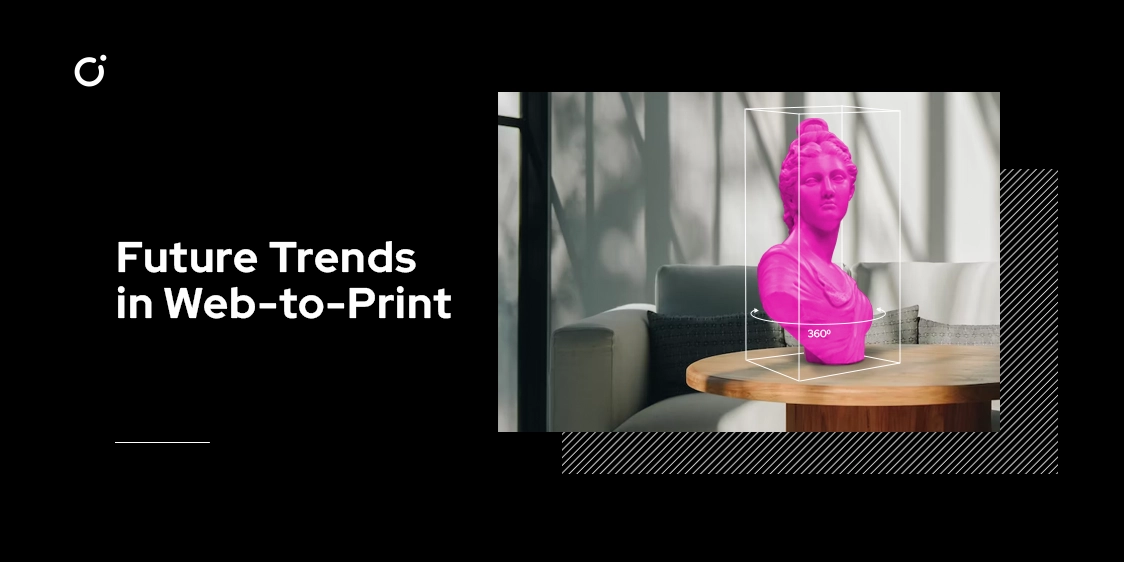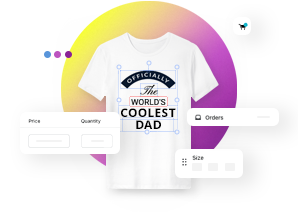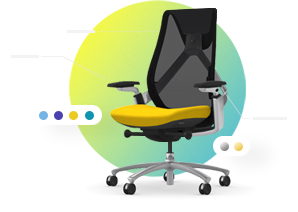On this page
Growth and future trends in web-to-print industry

In the last decade, the web-to-print industry has experienced significant growth and transformation. With advancements in technology and the increasing demand for personalized products, the print industry has adapted to meet the needs of consumers.
In this article, we will explore some of the key trends shaping the web-to-print industry for the upcoming years.
Evolving technologies and their impact on web-to-print solutions
A few key drivers shaping web-to-print industry future definitely are:
- Print automation
- 3D printing
- AR and VR revolution
Print Automation: Streamlining Processes for Efficiency
Automation and integration have become crucial factors in the growth of web-to-print solutions. Integration with various systems, such as e-commerce platforms, customer relationship management (CRM) tools, and print production workflows, streamlines the entire printing process, from design to delivery. Print automation reduces manual interventions, minimizes errors, and accelerates order processing, leading to improved efficiency and customer satisfaction.
3D Printing
Although still in its early stages, 3D printing has the potential to transform the web-to-print industry. By enabling the creation of three-dimensional objects, this technology offers a new dimension of personalization.
Customers can design and customize complex 3D models using web-to-print interfaces, which can then be printed using additive manufacturing techniques. As 3D printing becomes more accessible and affordable, it opens up opportunities for unique and customized printed products.
Augmented Reality (AR)
And of course, the all so talked about - augmented and virtual reality. AR technology is increasingly being utilized in web-to-print solutions to enhance the customer experience.
With AR, users can visualize how their custom designs will look in the real world, such as seeing a printed product overlaid on their physical environment through a smartphone or tablet camera. This interactive and immersive experience helps customers make informed decisions, boosting confidence and reducing the chances of dissatisfaction with the final printed product.
One step further we have witnessed the first experiments with virtual reality features. However, while virtual reality (VR) is an emerging technology with great potential, its implementation in web-to-print businesses is still relatively limited. As of now, the adoption of AR is far more advanced and achievable than VR.
Future trends of web-to-print industry
After discussing the technologies that must be thought through in your business if you’re thinking 5 years ahead, there are also certain things that you must address now. So let’s talk about all of the web to print industry trends for the future in one place.
Rise of Web-to-Print Marketplaces
Web-to-print marketplaces will gain traction as centralized platforms that connect customers with print service providers. These marketplaces will offer a wide range of customizable products, enabling customers to explore multiple options from various vendors.
Such platforms will facilitate easy price comparison, quality assessment, and seamless transactions, providing customers with a one-stop solution for their printing needs.
Artificial Intelligence (AI) Empowered Design Assistance
AI will play a more significant role in web-to-print tools, offering intelligent design assistance. AI algorithms will analyze user preferences, previous designs, and industry trends to generate design recommendations, suggest color palettes, or propose layout options. This integration of AI will streamline the design process, saving time and enhancing creativity for users.
Quality Assurance and Visual Proofing
Customers value assurance regarding the quality and accuracy of their customized designs before committing to the final product. They seek web-to-print products that provide visual proofing capabilities, allowing them to preview and approve their designs before printing.
This feature ensures that customers clearly understand of how their personalized product will look, reducing the risk of errors or dissatisfaction.
That’s why augmented reality (AR) has gained so much interest all these years and will continue to make its mark in the web-to-print industry. Web-to-print tools will integrate AR functionalities, allowing customers to visualize their printed designs in real-world environments using smartphone or tablet cameras.
The 3D Trend
While 3D printing was initially limited to prototyping and niche markets, it has now become more accessible and affordable. This technology allows customers to create three-dimensional objects, ranging from customized figurines to functional prototypes.
As the demand for 3D printing continues to rise, print centers can explore new opportunities by integrating 3D printing capabilities into their services. This trend opens doors for innovative applications, such as personalized home decor, customized medical devices, and even 3D-printed fashion accessories.
Increasing growth in mobile users
We have seen a massive increase in mobile traffic to websites in all industries, but the most affected one is without a doubt - e-commerce. So with the proliferation of smartphones and tablets, the web-to-print industry has embraced mobile responsiveness to cater to the growing demand for mobile-based customization.
Even though not many web-to-print shops can call themselves very mobile-friendly at the moment, it should become a standard to allow users to conveniently design and personalize printed materials on their mobile devices, online. The use of responsive design techniques ensures that the user interface adapts to different screen sizes, providing an optimal viewing and interaction experience.
So you have to adapt too. Mobile responsiveness and modern interfaces should be a strong deciding factor when choosing your web-to-print tool and staying ahead in the growing digital market.
Meeting the Demand for Personalization
The era of personalization is only gaining speed. Consumers increasingly seek unique and customized products. The web-to-print industry has recognized this trend and responded by offering extensive product customization and configuration options.
From personalized stationery and promotional materials to custom-designed apparel, print centers now provide a wide range of choices for customers to personalize their products. By incorporating robust online design tools and interactive interfaces, print centers can cater to individual preferences and offer a more engaging user experience.
As customers continue to value personalization, custom print service providers that excel in providing customized solutions in a simple way are likely to thrive in the future.
Sustainable and Eco-Friendly Printing
Last but not least, sustainability will play a significant role in the future of web-to-print. Increasing environmental consciousness and regulations will drive the adoption of eco-friendly printing practices and materials.
Web-to-print businesses will offer more options for recycled or biodegradable materials, promoting efficient use of resources, and reducing waste. With time we can already notice how more and more customers prioritize eco-friendly choices, so businesses that align with sustainable practices will gain a competitive edge.
Embracing Technology and E-commerce for Web-to-Print Success
The whole e-commerce engine plays a very important role in the growth and success of your web-to-print business. So when considering web-to-print trends, be mindful of the current stage of your online shop and integrate them into your daily business one at the time. And as it's a long journey here are a few tips that can really make a difference when growing your web-to-print shop.
Reliable E-commerce Platforms: Invest in a reliable and feature-rich e-commerce platform that is specifically designed for web-to-print businesses. These platforms offer essential functionalities such as product catalogs, online design tools, shopping carts, secure payment gateways, and order management systems. A seamless and user-friendly e-commerce platform can streamline the entire customer journey, from product selection to order fulfillment.
Strategic Partnerships and Business Development: Collaborate with strategic partners, such as printing equipment manufacturers, material suppliers, graphic designers, and marketing agencies, to expand your service offerings and reach a wider audience. By forming mutually beneficial partnerships, you can tap into new markets, access specialized expertise, and provide comprehensive solutions to your customers.
Extensive Product Catalog: Offer a wide range of products that can be personalized and customized. From business cards and flyers to apparel and promotional items, provide a diverse selection to cater to different customer needs. Clearly showcase product details, specifications, pricing, and customization options to help customers make informed decisions.
Marketing and Promotion: Implement a comprehensive marketing strategy to promote your web-to-print e-shop. Utilize various channels such as social media, search engine marketing, content marketing, and email campaigns to reach your target audience. Offer special promotions, discounts, and loyalty programs to attract new customers and encourage repeat business.
Summary
In conclusion, technologies continue to advance, and we can anticipate further innovations, improved and more immersed user experiences, as well as a broader range of personalized printed products in the future. However, the era of unprofessional user interface is coming to an end, so the web-to-print industry will definitely move towards providing even more dynamic experiences, with a first priority being a fluent e-commerce customer journey and ease of use in product customization. For that, your e-commerce platform, software choice, and good partners become crucial parts for future growth.
Tags
You can add a conetnt on the right side bar.

